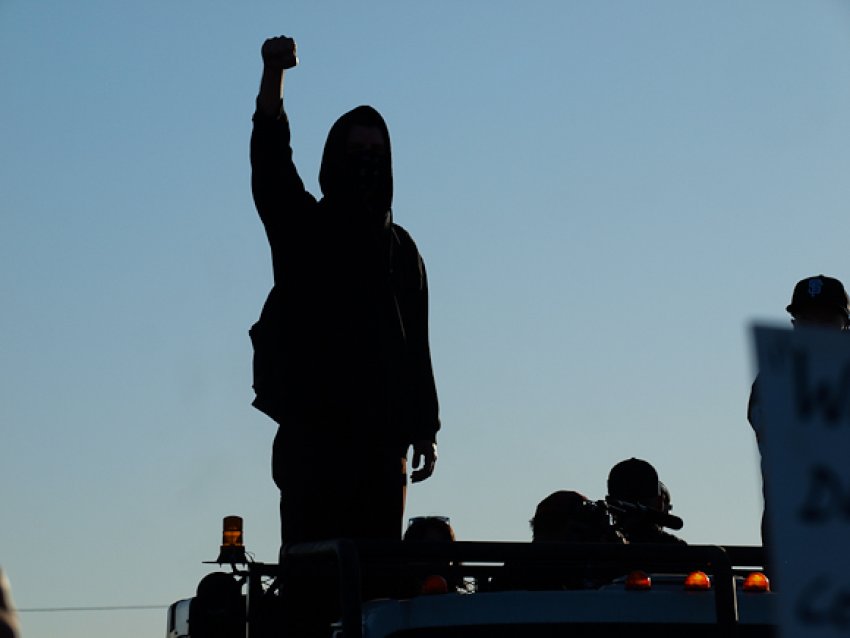
Occupy has gone viral. First we had flash trading, then flash mobs, and now a flash movement.
But this is no flash in the pan.
The Occupy movement is here to stay, come hell or high water, because the status quo is unacceptable. Not since the 1930s and 1960s have tens of thousands of people in the US been this defiant and determined to win economic and social justice.
What is unfolding is in many ways a synthesis of the movements of those eras.
Our emphasis on mass, non-violent resistance in the face of repression is a product of the civil rights movement.
When four black students used the occupy tactic at a whites-only Woolworths lunch counter on February 1, 1960, they had no idea they would trigger a wave of occupations at lunch counters throughout the south and solidarity pickets at segregationist stores in the north.
Similarly, the Occupy movement spread to 250 cities and towns in every region of the country in less than a month.
Occupy has spread to thousands of cities and towns around the world — including in South Korea, Pakistan and Australia.
After the passage of the Civil Rights Act in 1964, Dr Martin Luther King launched a Poor People’s Campaign. He saw this as “the opening of a bloodless war to final victory over racism and poverty”.
King was aiding a black sanitation workers’ strike when he was murdered in Memphis, Tennessee, in 1968.
Today, the occupiers in Liberty Plaza in New York sport buttons from the 1963 march for jobs and freedom where King gave his “I Have a Dream” speech — a sign that King’s struggle against poverty and racism did not die with him.
It took a decade before the civil rights movement spread north into inner city black and Hispanic communities, but it took just weeks for Occupy the Hood to appear.
The support of unions from the get-go allowed us to avoid the hardhat-activist divide that plagued the 1960s movements.
The occupy tactic was pioneered in the 1930s by the unemployed, war veterans, and labour movements.
The “Bloombergville” occupation (an encampment outside New York City Hall) that came just before Occupy Wall Street sought to highlight the plight of people affected by NY Mayor Michael Bloomberg’s budget cuts. It did so by creating modern day “Hoovervilles”, the Great Depression’s shantytowns that thousands lived in after they lost their homes, jobs and savings as the Hoover administration did nothing.
In the early '30s, thousands of unemployed people occupied parks near city halls demanding jobs, unemployment benefits, and government relief. Many of these occupations were dispersed by the police, but they succeeded with the creation relief programs and public works projects.
In 1932, tens of thousands of unemployed World War I veterans occupied Capitol Hill in Washington DC, seeking the bonus Congress promised them for wages lost while they served in European trenches.
They were brutally dispersed by the US military, but ultimately won when Congress passed the GI bill in 1944, giving veterans money for college and low-interest loans to buy homes and start businesses.
Workers in Flint, Michigan, occupied their factories in 1936, sparking copycat actions in workplaces all over America that eventually gave birth to the AFL-CIO union federation.
Video: Sit Down. uaw4me.
History came full circle when the AFL-CIO, created by the occupy tactic, mobilised its members early on October 28 to block Mayor Bloomberg from evicting us.
The Occupy movement and the unions are catalysts for one another. We march with union workers locked out by Sotheby’s, with Verizon’s union members, and alongside postal workers who are fighting mass layoffs.
Because of the Occupy movement, the AFL-CIO recently signed up 25,000 new, unorganised workers in one week.
Some of us may not realise it, but we stand on the shoulders of the giants who came before us.
[Pham Binh is a participant in Occupy Wall Street. His articles can be found at www.planetanarchy.net .]